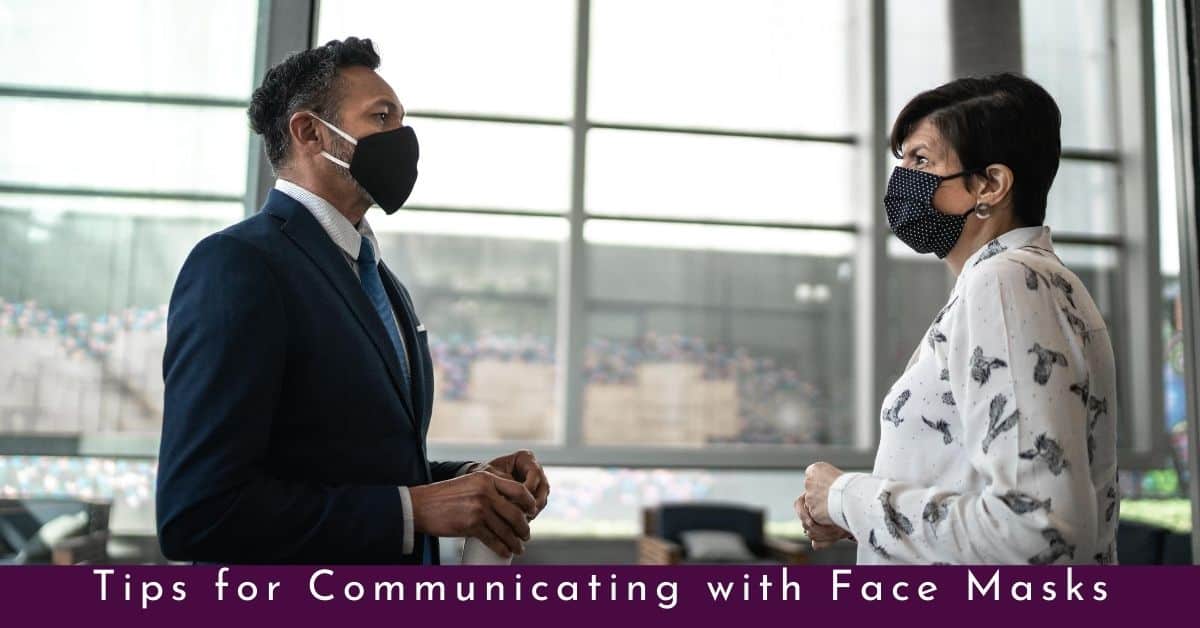
Health experts are reminding us that an effective way to slow the spread of COVID-19 is to wear face masks. We’re being encouraged to keep our mouths and noses covered, and stand at least six feet away from each other. This can make it harder to hear and understand what’s being said. We want you to find ways to communicate while being safe, so here are some tips for communicating with face masks.
Face Masks Can Make It Harder to Communicate
Masks are an effective way to reduce the spread of COVID-19, but face masks can make communicating more challenging, especially if you have hearing loss. The mask can actually stop certain high frequency sounds from reaching your ear. For example, when you wear a face mask your conversation partner will have a harder time hearing consonant sounds like “f”, “s”, “sh”, and “th”. When you can’t hear these sounds, it makes it much harder to understand what’s being said.
Masks can make it harder to have a conversation by:
- Muffling sounds and blocking consonants, making it harder to hear each word clearly.
- Blocking the lips and lower half of the face, making it impossible to read lips and making it difficult to read facial expressions.
- Causing discomfort if you wear behind-the-ear hearing aids or have a cochlear implant.
Even with these added challenges in communicating, it’s important to keep your mask on, and stand at least six feet away from others.
Tips for Communicating with Face Masks
We can all learn how to communicate effectively while wearing face masks. Here are some tips for communicating with face masks:
- Make sure you have your conversation partner’s attention before you start speaking. You can wave to them or call their name.
- Face each other directly. Don’t speak while facing to the side, and make sure there is nothing in between you and the person you’re talking to.
- Talk a bit louder than you normally would so your voice carries through the mask, but don’t shout.
- Talk a little slower than you normally would. This will help your conversation partner process what you’re saying, and give them a chance to ask for clarification if they didn’t understand everything you’ve said.
- Use your hands while you talk as well as your body language. Relax your shoulders, nod your head, and use your eyebrows to communicate. This will help overcome the limitations of not seeing facial expressions clearly.
- Stop often to make sure you’re being understood. Repeat yourself, rephrase what you said, or write down the important points you’re trying to communicate.
- Make sure you’re having the conversation in a quiet place. Background noise will make it even harder to hear what’s being said.
- You can also ask your conversation partner if there’s anything you can do to help them hear you more clearly. They may ask you for another accommodation that can make it easier for them to hear.
Tips for Wearing Face Masks with Hearing Aids
If you are wearing a hearing aid or an implant that sits behind your ears, a face mask with ear loops might be uncomfortable or interfere with your hearing aid. Here are a few alternatives to securing your face mask:
- You can secure your face mask to a cloth headband, so it’s not wrapped behind your ear.
- You can use a button extender on the back of your head and secure your mask to the extender.
- You can find a mask with four ties instead of ear loops, and tie the mask behind your head.
You may also be able to find some mask alternatives. For example, there are some masks that have a clear panel over the mouth. You can ask the person you’re speaking with to wear a mask that will let you see their lips and face. You can also protect yourself with a clear face shield, or stand on opposite sides of a clear plastic barrier.
Treating Hearing Loss
We understand that wearing face masks in public places can make it harder to communicate, especially if you have been struggling with hearing loss. Contact us to schedule a consultation for a hearing test and begin your journey to better hearing.
